Research and scholarly material on flame and combustion.
TO
| Creator | Title | Date | Description | ||
|---|---|---|---|---|---|
| 76 |
 |
Walsh, Peter M.; Moyeda, David K.; Lanier, W. Steven; Booth, C. Michael; Folk, E. E. (Gary); Maxwell, ?John; Whitcraft, Wilfred K.; Noble, Roger K.; Clopton, Jeff M.; Rogers, Tracy; Nicely, Chris; Rosensteel, Robert E.; Miller, C. Andrew | Hydrogen flares: the DuPont-EER-EPA test program, amendment of the EPA requirements, and related developments | 2010-09-30 | |
| 77 |
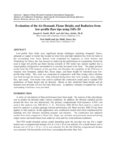 |
Smith, Joseph D.; Suo-Anttila, Ahti; Smith, Scot K.; Modi, Jay B. | Evaluation of the air-demand, flame height, and radiation from low-profile flare tips using ISIS-3D | 2007 | Low-profile flare fields pose significant design challenges including elongated flames, adequate air supply to burner tips located on inner rows and high radiation flux from the flame to the surrounding wind fence. Recent work completed by engineers at Alion Science and Technology for Zeeco, Inc. ha... |
| 78 |
 |
Foley, C. W.; Chterev, I.; Seitzman, J.; Lieuwen, Tim | Flame configurations in an annular swirl burner | This paper describes an experimental investigation of flame configurations in a swirling, lean premixed combustor. The flame configuration or stabilization location within the combustor has important influences upon a variety of combustor performance metrics, such as combustion instability limits an... | |
| 79 |
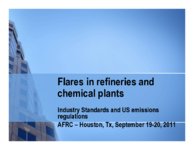 |
Henneke, Mike; Matos, Miguel | Flares in refineries and chemical plants | 2011 | |
| 80 |
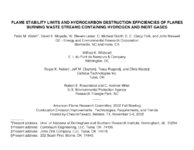 |
Walsh, Peter M.; Moyeda, David K.; Lanier, W. Steven; Booth, C. Michael; Folk, E. E. (Gary); Maxwell, John.; Whitcraft, Wilfred K.; Noble, Roger K.; Clopton, Jeff M.; Rogers, Tracy; Nicely, Chris; Rosensteel, Robert E.; Miller, C. Andrew | Flame stability limits and hydrocarbon destruction efficiencies of flares burning waste streams containing hydrogen and inert gases | 2002 | |
| 81 |
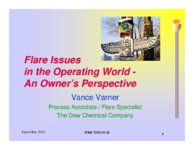 |
Varner, Vance | Flare issues in the operating world - an owner's perspective | 2010-09 | |
| 82 |
 |
Grandmaison, E. W. | Flames with flare and momentum - hazards to offshore platform boom structures and potential mitigation | ||
| 83 |
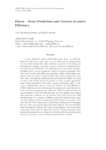 |
Hantsck, Carl-Christian; Schorer, Edwin | Flares - noise prediction and thermo-acoustic efficiency | 2004 | In many industries where combustible waste gases are obtained, flares are used to burn these gases in a controlled manner. Among other environmental aspects the noise emissions associated with flaring are becoming increasingly important in many countries as population density goes up and residential... |
| 84 |
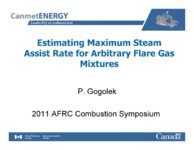 |
Gogolek, Peter E.G. | Estimating maximum steam assist rate for arbitrary flare gas mixtures | 2011 | |
| 85 |
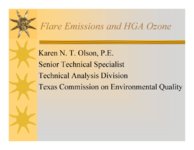 |
Olson, Karen N. T. | Flare emissions and HGA ozone | 2002-11-17 | |
| 86 |
 |
Muhasilovic, M.; Duhovnik, J.; Deville, M. O.; Ciahotny, K.; Koza, V. | Both LES and k-e turbulence-treatment in CFD-approaches for creation of the database on flare-stacks flame-behaviour | 2009 | There is an emerging importance to understand and to "map" the reacting complex-flows of the (larges-cale) flare-fires. In this study, the influence of the atmospheric events onto the flame-behaviour, has a start-up in investigation, by watching the development of the temperature-, velocity- and irr... |
| 87 |
 |
Henneke, Mike; Matos, Miguel | CFD analysis of a ground flare system: wind and fence effects on air supply behavior and thermal radiation | 2011 | Thermal radiation emitted from ground flare installations is a safety consideration • The fence material must be selected to tolerate the high heat fluxes • The fence has an influence on air supply to the burners and can cause air circulation patterns within the fenced area |
| 88 |
 |
Giovanardi, Enrico | Open Ground Flare systems - Hystorical review of a recent project from the concept to the commissioning, passing through R&D activities Presentation and Discussion of the Results of R&D activities as a basis for design and execution stage. | 2011 | The more and more restrictive environmental laws and regulation applied in most of the projects all over the world led in the last years to the need to increase on one hand smokeless performances of assisted flares, to guarantee smokeless combustion up to Ringelmann 0, and, on the other hand to inst... |
| 89 |
 |
Wheeler, W. H. | Chemical & engineering aspects of low NOx concentration | 1980-07-07 | Two new requirements for low NOx emission from industrial combustion installations are explained. One, which is directed against a previously unsuspected and dangerous form of contamination of certain food-stuffs, calls for a NOx concentration not exceeding 1 ppm at the burner mouth; and the other i... |
| 90 |
 |
Zeuthen, Jacob Hjerrild; Pedersen, Anne Juul; Riber, Christian; Astrup, Thomas; Hansen, Jorn; Frandsen, Flemming Jappe; Livbjerg, Hans | Combustion aerosols from municipal waste incineration - effects of feedstock composition and boiler operation | 2009 | Combustion aerosols were measured in the 22 MWth FASAN Waste-to-Energy (WtE) boiler while applying changes in feedstock composition and grate operation conditions, respectively. The changes in feedstock composition were applied by adding (one-by-one) dedicated waste fractions, comprising PVC plastic... |
| 91 |
 |
Hu, Shengteng; Zeng, Dong; Sarv, Hamid | Applying laser-induced incandescence (LII) technique to soot volume fraction measurements for pyrolyzing pulverized coal | 2009 | Staged combustion and gasification of coal are conducive to soot formation. Presence of soot in combustion systems can affect heat transfer, pollutant formation, and unburned carbon levels.Development of an accurate soot production model requires high-quality experimental data. For this purpose, the... |
| 92 |
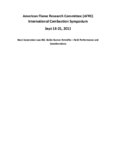 |
American flame research committee (AFRC) international combustion symposium | 2011 | Burner retrofits in industrial boilers are an economical solution to achieving lower NOx levels with existing fired equipment. However, designing a next generation ultra-low NOx burner footprint that fits into an existing burner cutout continues to be an industry challenge in many applications. Buil... | |
| 93 |
 |
Smith, Philip J.; Kumar, Seshadri; Spinti, Jennifer; Desam, Padmabhushana R.; Borodai, Stainslav G. | An LES analysis of industrial flare performance under high wind conditions | 2005 | |
| 94 |
 |
Industrial Monitor & Control Corporation | Active and passive monitoring of flare combustion efficiency | 2011-09-19 | |
| 95 |
 |
Spellicy, Robert L. | Active and passive FTIR monitoring of flare combustion efficiency | ||
| 96 |
 |
Acceptable operating parameters for steam assisted flares at Purge Rates | Flare vendors recommend that cooling steam should always be supplied to the steam injection equipment on steam assisted flare tips. However, the nomenclature of "cooling steam" properly describes only one aspect of this steam flow. Not only does this steam provide thermal protection to the steam inj... | ||
| 97 |
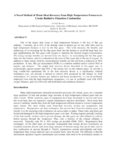 |
Atreya, Arvind; Kezerle, James A. | A novel method of waste heat recovery from high temperature furnaces to create radiative flameless combustion | 2009 | One of the largest heat losses in high temperature furnaces is the loss of flue gas enthalpy. Currently, up to 60% of the heating value of natural gas (or any other fuel) used in high temperature furnaces is lost via the flue gases. This work discusses the benefits and technology of re-circulating t... |
| 98 |
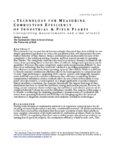 |
Smith, Philip J. | A technology for measuring combustion efficiency of industrial & field flares (integrating measurements and simulations) | 2011-08-12 | Flare research over the past decade has increasingly illustrated that there is likely no one simple operational parameter (or even a few parameters) that will characterize the combustion behavior of flare flames.i Simple correlations are unobtainable because of the complexity of the nonlinear mixing... |
| 99 |
 |
Wheaton, Zachary; Stroh, David; Krishnamoorthy, Gautham; Muhammad, Sami; Orsino, Stefano; Nakod, Pravin | A comparative study of gray and non-gray methods of computing gas absorption coefficients and its effect on the numberical predictions of oxy-fuel combustion | Computational Fluid Dynamics (CFD) simulations are performed to model the radiation process in natural gas fired furnaces using different gray and non-gray radiation models. Simulations of two representative furnace cases (HTAC and OXYFLAM) were performed and the computed radiative fluxes compared w... | |
| 100 |
 |
Kodesh, Zachary; Fox, Scott; Franklin, James | Accurate and reliable flare testing methods | 2011-08-30 | Recently the Texas Commission on Environmental Quality (TCEQ), through The University of Texas (UT) initiated a project utilizing John Zink facilities to better understand the operating envelope of varying flare technologies across various process conditions. A large scale flare testing environment ... |
